
# 1185 - 1961 4c Naval Aviation
4¢ Naval Aviation
City: San Diego, CA
Quantity: 116,995,000
Printed by: Bureau of Engraving and Printing
Printing Method: Rotary Press
Perforations: 11 x 10 1/2
Color: Blue
Birth of Naval Aviation
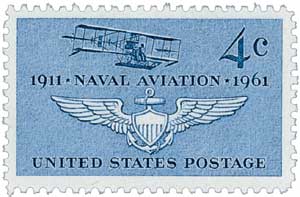
On May 8, 1911, the US Navy purchased its first airplane. This date is celebrated as the birth of US naval aviation.
Militaries have attempted to use aviation in warfare since the early 1800s. During the Napoleonic Wars, Napoleon sent hot air balloons up to observe enemy movements. Other militaries adopted this tactic, including the US during the Civil War. In 1898, Assistant Secretary of the Navy Theodore Roosevelt suggested that they explore the possibility of using aircraft in naval warfare. Though aviation was still in its infancy, the investigators saw the possibilities and the Navy worked with inventors designing planes. After the Wright brothers showcased their successful planes, they provided the Army with its first aircraft.

As aviation improved in the early 1900s, the US Navy watched closely, attending air shows and test flights. Naval planners knew that if they were going to use airplanes, they would need to safely take off from and land on ships. Captain Washington Chambers was in charge of the Navy’s aviation attempts. Since the Wright brothers were working with the Army, Chambers brought in Glenn Curtiss to help develop the Navy’s aviation program.
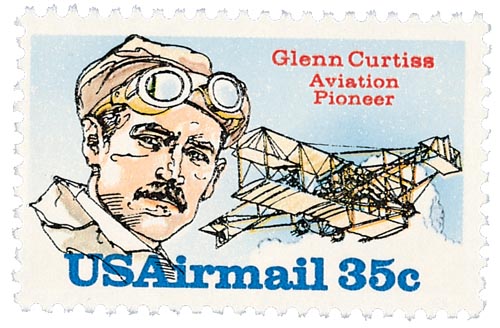
In 1910, Chambers had an 85-foot platform built on the USS Birmingham. On November 11 that year, exhibition pilot Eugene Ely piloted one of Glenn Curtiss’s aircraft from this platform. Though the plane damaged a propeller when it skimmed across the water, it managed to stay in the air for about two-and-a-half miles. This was enough to convince Chambers that planes could launch from ships.
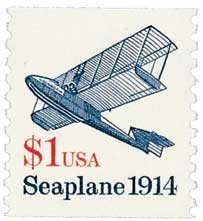
Next, Chambers had a 120-foot platform built on the USS Pennsylvania. On January 18, 1911, Ely flew a plane toward the Pennsylvania. Traveling at about 40 miles per hour, he safely landed on the ship. The deck had been outfitted with cables and the plane with steel hooks, which successfully caught the lines and aided in his landing. A crowd was on board to witness the landing and erupted in cheers. Ely told a reporter “It was easy enough, I think the trick could be successfully turned nine times out of ten.” After a brief celebration, Ely launched the plane from the deck.
January 1911 saw another milestone in naval aviation. Curtiss had offered to train a pilot in the construction and operation of his airplane for free. The Navy took him up on the offer and sent Lieutenant Theodore “Spuds” Ellyson for that training, becoming the first official Navy pilot, Navy Aviator No. 1. Ellyson would go on to be the first naval pilot to fly at night and land on the water in the dark.
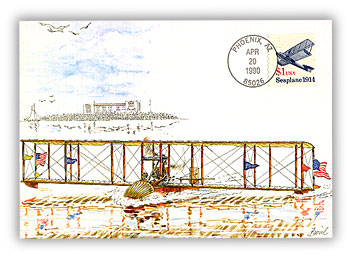
With these early successes, Chambers was convinced and ordered the Navy’s first plane, a Curtiss Triad A-1, on May 8, 1911, a date that is considered the birth of American naval aviation. The plane, known as the Curtiss hydroaeroplane A-1, was designed to take off and land on water and ground (hence, Triad). Curtiss made the first flight of the A-1 on July 1, 1911. Later the same day, Ellyson was the first Navy pilot to fly the A-1.
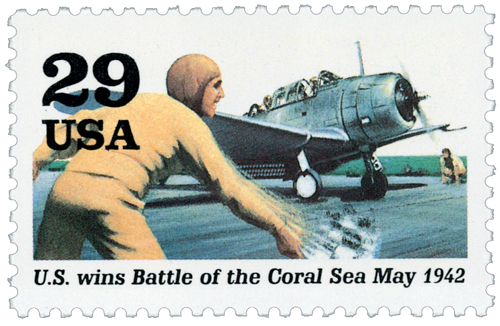
Most of the planes Curtiss developed for the navy were seaplanes. The temporary wooden decks built for the tests on the Birmingham and Pennsylvania blocked their gun batteries. It would be more than a decade until the Navy began building aircraft carriers that could fully support the takeoff and landing of planes. The navy would need planes for scouting and ferrying cargo and people over water much sooner. So, Curtiss fitted his planes with pontoons, providing the Navy with seaplanes that could take off and land on the water.
The Navy slowly expanded its aviation program in the coming years. By the time the US entered World War I, it only had one air station, 48 pilots and students, and 54 planes. The war brought on massive expansion, with several different types of planes being rushed into production and thousands of aviators, officers, mechanics, and more joining the program. Naval aviators performed well during the war, flying more than three million miles, and damaging 12 German submarines.
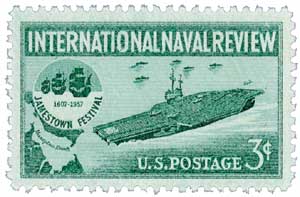
After the war, naval aviators were the first to fly across the Atlantic, in Curtiss NC flying boats. And in 1922, the first US aircraft carrier, Langley, was commissioned. Aircraft carriers and naval aviation would prove essential to the Allied victory in World War II, with Navy pilots shooting down more than 15,000 enemy planes, sinking 174 Japanese warships, and 63 German U-boats. The war also proved just how important effective naval aviation was to warfare.
4¢ Naval Aviation
City: San Diego, CA
Quantity: 116,995,000
Printed by: Bureau of Engraving and Printing
Printing Method: Rotary Press
Perforations: 11 x 10 1/2
Color: Blue
Birth of Naval Aviation

On May 8, 1911, the US Navy purchased its first airplane. This date is celebrated as the birth of US naval aviation.
Militaries have attempted to use aviation in warfare since the early 1800s. During the Napoleonic Wars, Napoleon sent hot air balloons up to observe enemy movements. Other militaries adopted this tactic, including the US during the Civil War. In 1898, Assistant Secretary of the Navy Theodore Roosevelt suggested that they explore the possibility of using aircraft in naval warfare. Though aviation was still in its infancy, the investigators saw the possibilities and the Navy worked with inventors designing planes. After the Wright brothers showcased their successful planes, they provided the Army with its first aircraft.

As aviation improved in the early 1900s, the US Navy watched closely, attending air shows and test flights. Naval planners knew that if they were going to use airplanes, they would need to safely take off from and land on ships. Captain Washington Chambers was in charge of the Navy’s aviation attempts. Since the Wright brothers were working with the Army, Chambers brought in Glenn Curtiss to help develop the Navy’s aviation program.

In 1910, Chambers had an 85-foot platform built on the USS Birmingham. On November 11 that year, exhibition pilot Eugene Ely piloted one of Glenn Curtiss’s aircraft from this platform. Though the plane damaged a propeller when it skimmed across the water, it managed to stay in the air for about two-and-a-half miles. This was enough to convince Chambers that planes could launch from ships.

Next, Chambers had a 120-foot platform built on the USS Pennsylvania. On January 18, 1911, Ely flew a plane toward the Pennsylvania. Traveling at about 40 miles per hour, he safely landed on the ship. The deck had been outfitted with cables and the plane with steel hooks, which successfully caught the lines and aided in his landing. A crowd was on board to witness the landing and erupted in cheers. Ely told a reporter “It was easy enough, I think the trick could be successfully turned nine times out of ten.” After a brief celebration, Ely launched the plane from the deck.
January 1911 saw another milestone in naval aviation. Curtiss had offered to train a pilot in the construction and operation of his airplane for free. The Navy took him up on the offer and sent Lieutenant Theodore “Spuds” Ellyson for that training, becoming the first official Navy pilot, Navy Aviator No. 1. Ellyson would go on to be the first naval pilot to fly at night and land on the water in the dark.

With these early successes, Chambers was convinced and ordered the Navy’s first plane, a Curtiss Triad A-1, on May 8, 1911, a date that is considered the birth of American naval aviation. The plane, known as the Curtiss hydroaeroplane A-1, was designed to take off and land on water and ground (hence, Triad). Curtiss made the first flight of the A-1 on July 1, 1911. Later the same day, Ellyson was the first Navy pilot to fly the A-1.

Most of the planes Curtiss developed for the navy were seaplanes. The temporary wooden decks built for the tests on the Birmingham and Pennsylvania blocked their gun batteries. It would be more than a decade until the Navy began building aircraft carriers that could fully support the takeoff and landing of planes. The navy would need planes for scouting and ferrying cargo and people over water much sooner. So, Curtiss fitted his planes with pontoons, providing the Navy with seaplanes that could take off and land on the water.
The Navy slowly expanded its aviation program in the coming years. By the time the US entered World War I, it only had one air station, 48 pilots and students, and 54 planes. The war brought on massive expansion, with several different types of planes being rushed into production and thousands of aviators, officers, mechanics, and more joining the program. Naval aviators performed well during the war, flying more than three million miles, and damaging 12 German submarines.

After the war, naval aviators were the first to fly across the Atlantic, in Curtiss NC flying boats. And in 1922, the first US aircraft carrier, Langley, was commissioned. Aircraft carriers and naval aviation would prove essential to the Allied victory in World War II, with Navy pilots shooting down more than 15,000 enemy planes, sinking 174 Japanese warships, and 63 German U-boats. The war also proved just how important effective naval aviation was to warfare.









